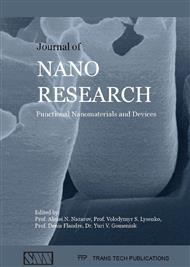p.96
p.105
p.114
p.121
p.134
p.151
p.162
p.169
p.178
Silicon Nanocrystalline Nonvolatile Memory - Characterization and Analysis
Abstract:
In this work, nanocrystal nonvolatile memory devices comprising of silicon nanocrystals located in gate oxide of MOS structure, were comprehensively studied on specialized modular data acquisition setup developed for capacitance-voltage measurements. The memory window formation, memory window retention and charge relaxation experimental methods were used to study the trapping/emission processes inside the dielectric layer of MOS capacitor memory. The trapping/emission processes were studied in standard bipolar memory mode and in new unipolar memory mode, which is specific for nanocrystalline nonvolatile memory. The analysis of experimental results shown that unipolar programming mode is more favourable for nanocrystalline memory operation due to lower wearing out and higher breakdown immunity of the MOS device’s oxide. The study was performed for two types of nanocrystalline memory devices: with one and two silicon nanocrystalline 2D layers in oxide of MOS structure correspondingly. The electrostatic modelling was presented to explain the experimental results.
Info:
Periodical:
Pages:
134-150
Citation:
Online since:
February 2016
Authors:
Price:
Сopyright:
© 2016 Trans Tech Publications Ltd. All Rights Reserved
Share:
Citation:


